-
Many of you who have been with Cavaliero Finn from the beginning will know that we have been working with Japanese ceramicist, Ikuko Iwamoto, practically since we started the gallery back in 2004, initially showing her sea urchin containers and spiky, spiky bowls after she completed her MA at the RCA in 2006.
Ikuko’s work is inspired largely by her own curiosity of the microscopic world – the cells, genes and organic forms that are invisible to the naked eye. Her meticulous attention to detail and adept technical skills enable her to uniquely interpret the world that inspires her, creating ceramic sculptures which take their reference from the tiniest of sea creatures to the minutest of micro-organisms.
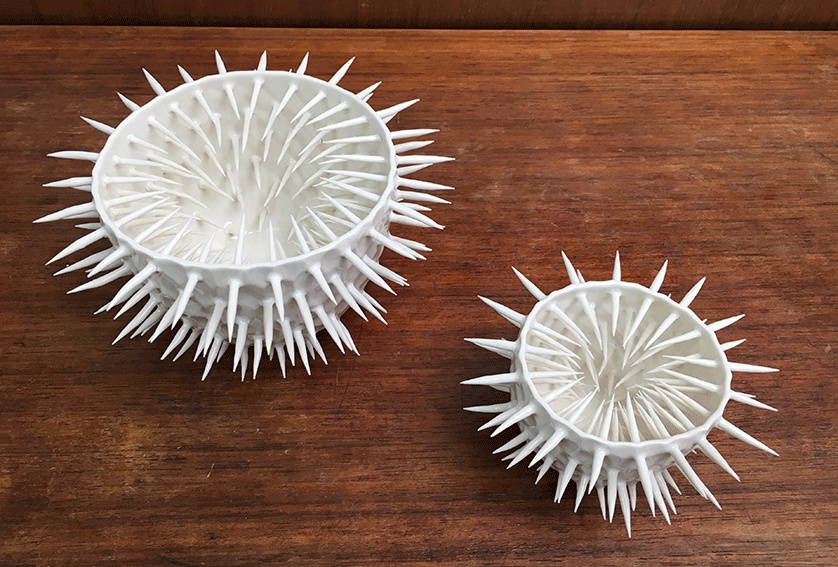
Spiky, Spiky Bowls, porcelain, approx 8 cm x 15 cm x 15 cm large size. Over the years we have seen Ikuko’s work and confidence grow and while her tabletop ceramic works are still very popular, we have really enjoyed the development of Ikuko’s sculptural pieces. A development that had been dormant for several years from when she was at Tezukayama College in Japan, Ikuko’s freestanding sculptural forms have been translated into boxed frames making them more two-dimensional and thrusting them firmly into the realms of fine art, a progression that won her the Young Masters Maylis Grand Ceramic Prize late last year.
Speaking of Ikuko’s work at the Young Masters Art Prize exhibition, curator and art historian Stephen Feeke said:
“It’s just totally original, with a reference to art history in a very interesting way, it’s surrealism, [referencing] people like Cornell, and yet it feels utterly, utterly, original in its use of ceramic and its use of mixed media.”
We couldn’t agree more. Ikuko is, without doubt, an artist of extreme talent on both a creative and technical level and her work ethic is an absolute inspiration, as she constantly seeks to push her work to the next level, often working until late into the night to do so.
We talked to Ikuko about her work earlier this week to find out more.
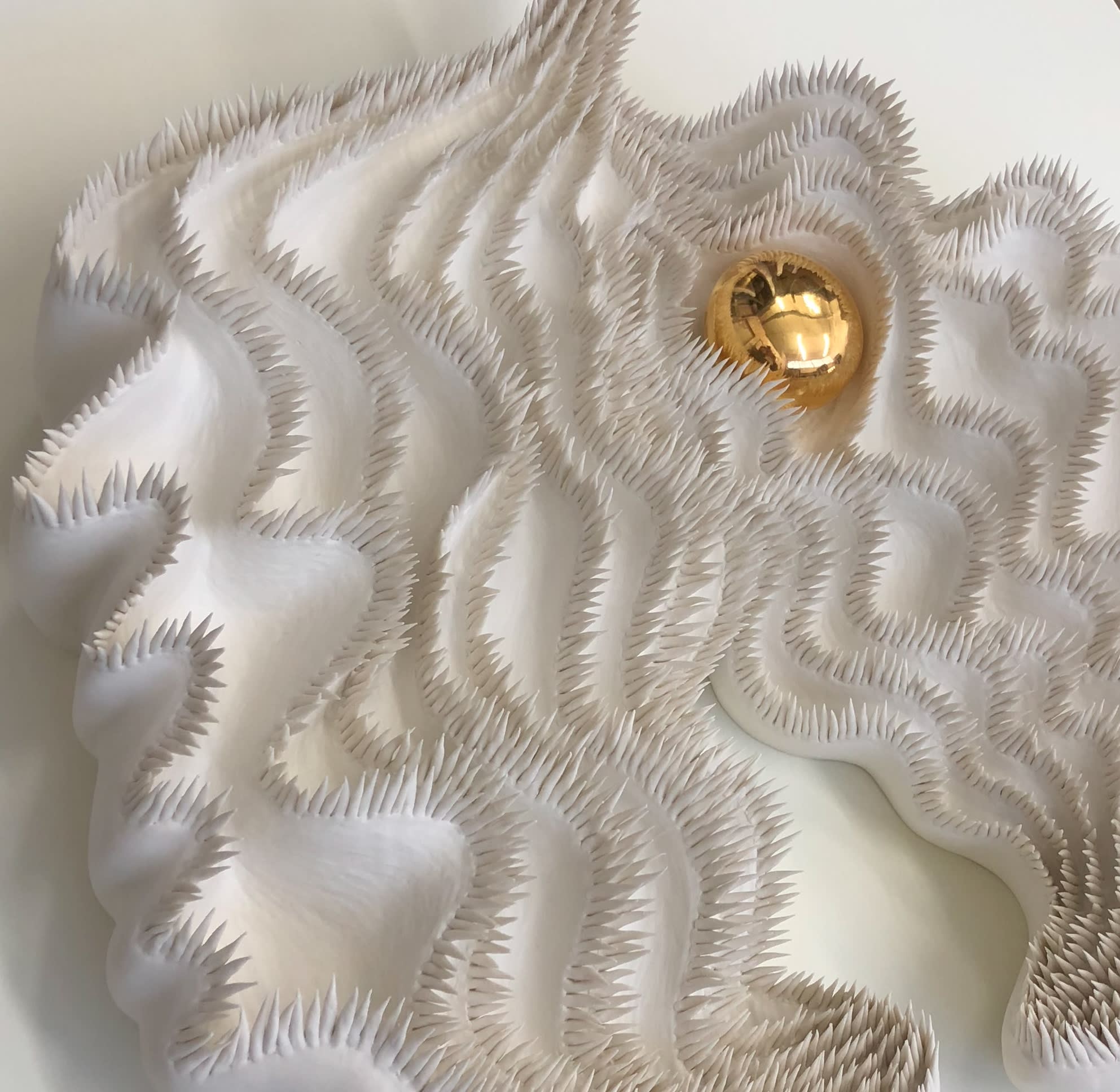
Detail of one of Ikuko’s framed Golden Pearl Series. CF: Ikuko, what started your career in ceramics? Did you always know you would work in the creative industry and when was your first encounter with clay?
Ikuko: I never knew I was going to work as a ceramicist and it was a bit by accident, actually. When I was small, I wanted to become a painter, but I was told by a teacher in secondary school that I had no talent for 2D work. I was devastated and gave up that dream. Instead, I took exams to enter a number of universities which offered courses in the humanities and, as a back-up, I had taken an exam for a college which ran a craft history course which was just as well, as that was the only college that accepted me and that’s where I first encountered clay.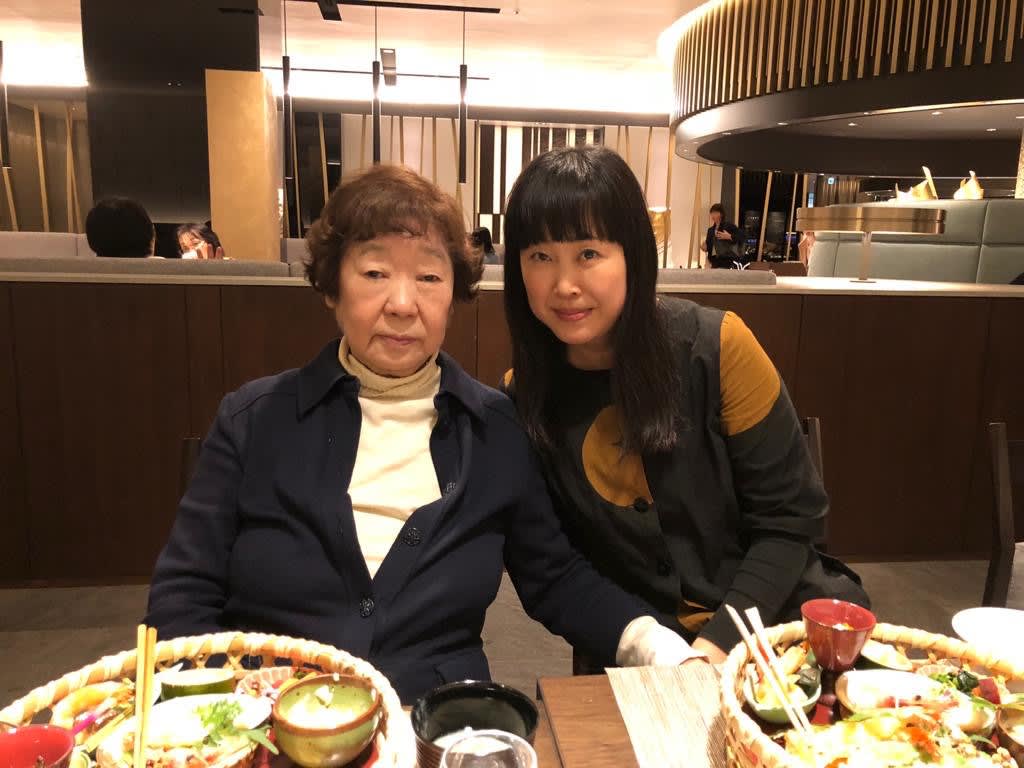
Asuka Tsuboi and Ikuko Iwamoto in Japan CF: Tell us about your training Ikuko, you had a special relationship with your tutor in Japan didn’t you? How did this come about?
Ikuko: I was lucky enough to be tutored by Asuka Tsuboi, and she was the one who suggested I study in London. After I had completed the craft history course, where I was trained to throw clay on the wheel for two years, starting with small things and working towards wide plates towards the end of the course, I remained as a research student and served an apprenticeship with Asuka. During this period, I created a series of hand-built clay sculptures which really opened my eyes as to the potential of the material. Without her recommendation, I would not have been working here in London, and I am totally grateful to her, I try to visit her whenever I go to Japan.

Buddy container, porcelain, 20cm h x 16cm w
Shown here alongside Ribsome vase and painting by Holly Frean.CF: In your opinion, is there a difference between the teaching styles in Japan and those of the UK and, if so, can you pinpoint what they might be?
Ikuko: For me, in Japan technique always comes first, and then you create whatever you do, and you are more or less judged by the technical quality of what you have achieved at the end. On the contrary, here in the UK, I believe the concept is very important, therefore, you spend lots of hours on the concept-making stage, and then you must be able to explain how and why you have created your work at the end. My work has benefited from both of these approaches.

Spiky Beaker, Porcelain, Approx 12cm wide x 11cm tall 2020 CF: Your work is very fragile, what is the most nerve wracking stage of the making process for you?
Ikuko: It is definitely the stage of packing my work into the kiln. I often create parts of my sculpture that are the maximum size that will just about fit in the inner size of the kiln. So, when I put my work on the shelf in the kiln, there is often not enough space for my hands what with all the spikes popping out from every part of my work. I always graze my hands on the edge of the kiln.

Nuclelous Pofu Pofu flower vase with gold gilt edges, Approximately 25cm high,
Photography by Michael HarveyCF: We love the videos you regularly post on YouTube explaining your techniques and process, why did you start doing these and what do you hope people will get from watching them?
Ikuko: I was looking for new ideas for shapes to feed into my vases, and I thought about working it out with a completely different approach, by creating shapes starting from a 2D aspect. The idea seemed totally fresh to me, and I wanted to see how far I could go with it. I simply set the number “100” as a goal for my challenge.
I combined this idea with YouTube to cement my commitment. You can quit at any time if nobody is watching, but you cannot if you are being watched… I also thought the process of making films would help to improve my English and presentation skills.
I hope people will be interested in creating ceramic works using the slip-casting technique by watching my YouTube channel because I personally believe it is a technique that expands boundaries for ceramicists enabling them to go into more of a fine art direction, and I would love to see lots more progressive ceramic artists in the future.Ikuko’s YouTube video of the making of Golden Pearl IV, her latest and largest wall frame sculpture yet CF: We are really drawn to your spiky works, for us the spikier the better. Tell us how this line of work has evolved from the spiky, spiky bowls which we presented in our early exhibitions to your largest wall work ever, Golden Pearl IV, which we presented at Collect this year?
Ikuko: After my graduation from RCA in 2006, I was really keen to develop my own ideas and techniques. Experimenting with different organic shapes, I found that spikes were really useful to create tension, and also fragility at the same time. “Spiky, spiky bowl” was one of the successful results from this period, and I started using spikes regularly.
In 2012, I showed a series of my framed sculptures for the first time at Ceramic Art London, and eventually I started to think about going for larger-scaled work.
Since then I have incorporated many elements into my framed works, from using more tableware-based elements, to more compositional and mixed-media ones like the piece (shown at the start of this post) that won the Young Masters Prize last year. When I made my first “Golden Pearl” for Collect in 2018 I realised it had got a style and depth that offered many opportunities. Its organic form with lines of spikes allows you to create the flow over the form. I can be really obsessive with this series of work.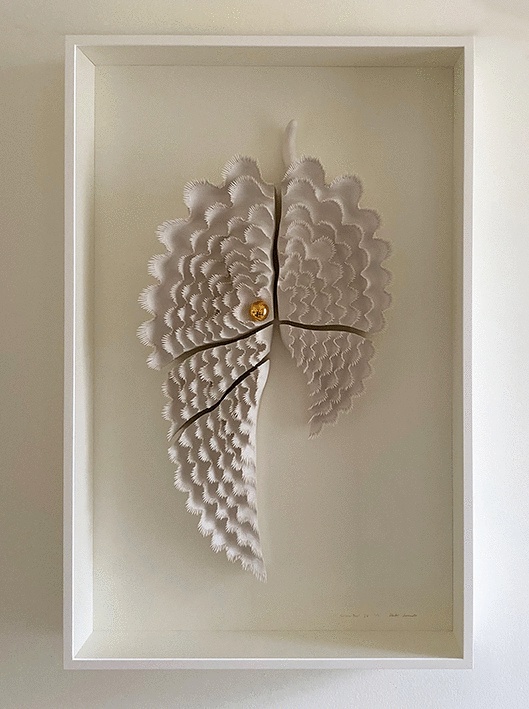
Golden Pearl IV, 2020, Porcelain and gold lustre, 125 x 80 x 17 cm framed, 2020 CF: How long would each part of something like Golden Pearl IV take you?
Ikuko: It depends on the size of the part, but roughly… 25~30 hours for the plaster model making, 35~40 hours for plaster mould making, 7~8 hours for slip casting, 7~8 hours for spike attachment, 1 day for firing and then it needs to be framed. When you think that the Golden Pearl IV sculpture has five individual parts to it, that’s a lot of hours in the studio!CF: You tend to work with a very limited colour palette – often only using gold on your more sculptural work and a small amount of colour on your functional ceramics. Why is this?
Ikuko: I like the natural white colour of porcelain (glazed or non-glazed), and it enables me to achieve the right forms and compositions for my work. I think using too many colours would kill what I am trying to achieve sculpturally. I believe that if you keep the colours down, the tension and other subtle nuances of your work will naturally stand out so I only use colours as an accent.
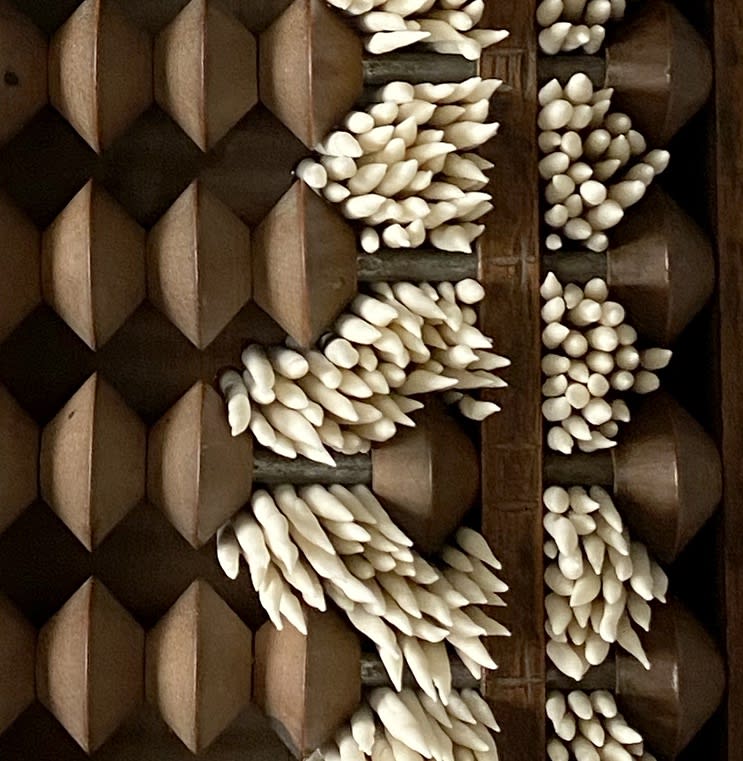
Detail of Abacus, porcelain and manmade object, H29cm x W11cm x D6.5cm, 2020 (sold) CF: Tell us about your new antique work? What gave you the idea to combine antiques with your spiky forms and what does the addition of gold lustre add to the work, in your opinion?
Ikuko: Each antique object I work with is handcrafted and has got individual character and history. I tend to work with functional objects that would have had an everyday use, so, domestic tools for the garden and kitchen for example. I’ve even used the ancient tools of accountants working with an antique abacus and money measurer both of which sold at Collect this year.
I have always thought that porcelain’s natural white colour is a perfect match for these kind of objects, and I imagined that by adding an extra dimension to them, would make them even more exciting.
It’s more about adding than creating from the beginning with this project, and because the spike attachments are more ornamental, they were a natural choice for me. The addition of gold lustre elevates the functional status of the antique objects further into the ornamental domain.
Scoop, Porcelain and man-made object, H46.5cm x W26cm x D9.7cm 2020 CF: Ikuko, you have lived in the UK for a number of years now, how has living over here influenced your work?
Ikuko: You have to be very driven to live in London as an artist. It is a very tough existence and every year for me has been a survival. I have always felt that if you stop or slow down, your work suffers and I am always thinking about the next body of work all the time. Whilst this pressure is hard to bear, it makes me push myself creatively.

Scoop (detail) Porcelain and man-made object, H46.5cm x W26cm x D9.7cm 2020 CF: Your work already appears in the permanent collection of the Victoria and Albert Museum and last year you won the Young Masters Prize, how does this make you feel? What would you like to achieve next?
Ikuko: These acquisitions and prizes give me a great deal of confidence and keep me going. I have a very strong work ethic and want my work to keep progressing and I would like to be able create new work which is larger in scale. For that to happen I will need a certain level of investment which will enable me to progress in this way.
CF: We very much look forward to seeing your work progress Ikuko. Thank you for talking to us today.
See more of Ikuko's available work here
